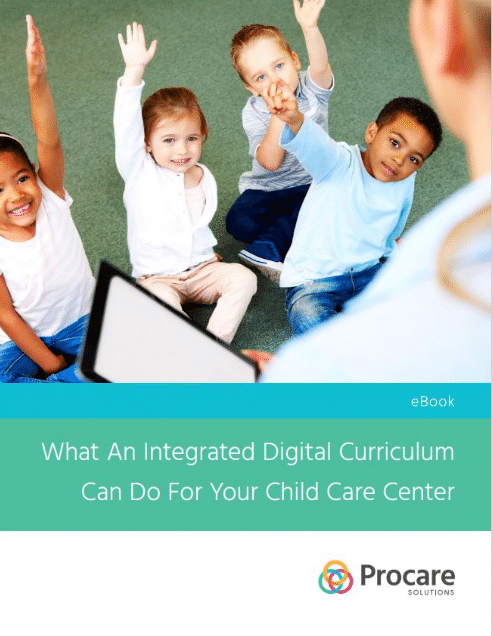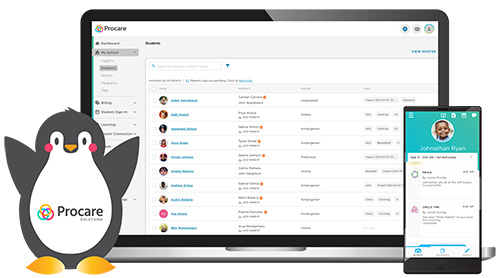This blog was originally posted on Jan. 6, 2021, and updated on Jan. 8, 2025, with new information.
Daycare lesson plans are ways to translate your state’s early learning standards and your center’s curriculum into fun, educational activities. A daycare care lesson plan is both structured and flexible, remembers the needs of every student and has measurable goals.
Yet the 2024 Child Care Management Software Industry Trends Report from Procare Solutions found that about 30% of survey respondents said each teacher spends between three and five hours a week doing lesson planning and a similar percentage noted their centers create their own curriculum:
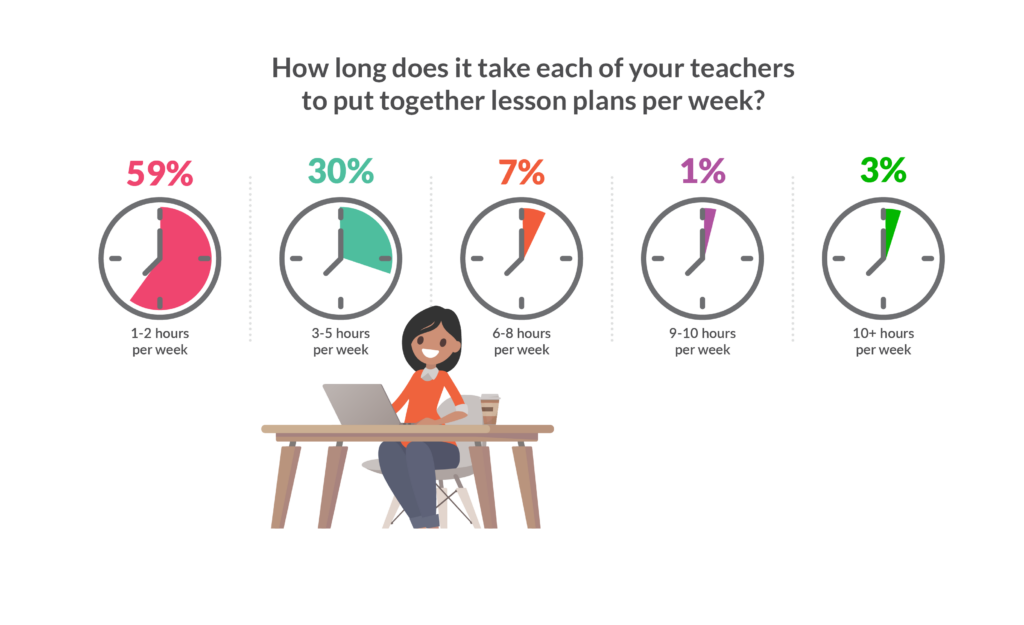
Read on to learn more about preschool lesson planning, and lesson planning for other age groups in daycare, and our expert tips for making lesson planning work for you!
What is Daycare Lesson Planning?
A lesson plan is your guide to teaching a class session. Whether you make one yourself or start with a premade template, your lesson plan sets the content and structure of what you will teach and how.
Lesson plans for daycare cover three key elements of a learning activity:
- Learning objectives (why the lesson is taking place and what kids should know by the end)
- Methodology (what specific activities and materials will be used)
- Assessment (how you will check the students’ understanding and the lesson’s efficacy)

Why is Lesson Planning Important?
Planning lessons in advance is indispensable for teachers. A well-planned lesson ensures you are covering all the necessary ground, making effective use of time and meeting the needs of every learning style.
Your preschool lesson planning will let you provide a structured learning experience for your students and make sure that they receive adequate opportunities across all learning domains. And an expertly-planned lesson lets you handle the unexpected with grace, including seizing on spontaneous learning opportunities.
Example of a Daycare Weekly Lesson Plan for 3-Year-Olds
Theme of the Week: Colors and Shapes
Objective: Introduce and reinforce the recognition of primary colors and basic shapes.
Monday:
- Circle Time: Sing a song about colors.
- Activity: Color Sorting – Provide children with colored blocks or toys and ask them to sort by color.
- Art: Finger Painting – Allow children to use primary colors to create their own artworks.
Tuesday:
- Circle Time: Read a story featuring different shapes such as “Mouse Shapes” by Ellen Stoll Walsh.
- Activity: Shape Hunt – Hide various shapes around the classroom and have children find and identify them.
- Art: Shape Collage – Provide pre-cut shapes and encourage children to create a collage.
Wednesday:
- Circle Time: Dance and move to a song about shapes such as”The Shape Song Swingalong”.
- Activity: Shape Puzzles – Simple puzzles where children fit shapes into corresponding outlines.
- Art: Playdough Shapes – Use playdough to form different shapes.
Thursday:
- Circle Time: Discuss the colors and shapes seen so far.
- Activity: Color and Shape Bingo – Create bingo cards with colors and shapes for a fun matching game.
- Art: Crayon Rubbings – Place various textured shapes under paper and color over them to reveal the shapes.
Friday:
- Circle Time: Recap the week’s activities and sing favorite songs.
- Activity: Shape and Color Scavenger Hunt – Combine both elements in a scavenger hunt.
- Art: Free Drawing – Allow children to draw whatever they like, encouraging them to use colors and shapes.
Daycare Lesson Plan Ideas for 4-Year-Olds
Theme of the Week: Seasons
Objective: Teach children about the four seasons and their characteristics.
Monday:
- Circle Time: Introduce the four seasons with a song such as”The Seasons Song.”
- Activity: Seasons Sorting – Provide pictures representing each season and have children sort them.
- Art: Seasonal Tree – Create a tree using handprints and change its leaves according to the season.
Tuesday:
- Circle Time: Read a book about a specific season such as “Goodbye Summer, Hello Autumn” by Kenard Pak.
- Activity: Weather Chart – Create a chart tracking the weather each day.
- Art: Snowflakes – Use coffee filters and scissors to make snowflake decorations.
Wednesday:
- Circle Time: Discuss seasonal clothing and why we wear certain clothes in each season.
- Activity: Dress Up – Provide clothes representing different seasons for a dress-up activity.
- Art: Sun Flowers – Create sunflowers using yellow construction paper and glue.
Thursday:
- Circle Time: Talk about seasonal activities such as swimming in summer or sledding in winter.
- Activity: Seasonal Activity Posters – Create posters showing activities for each season.
- Art: Leaf Prints – Collect leaves and use paint to make prints on paper.
Friday:
- Circle Time: Recap the week’s lessons and sing “The Seasons Song” again.
- Activity: Seasonal Craft – Choose a craft related to the child’s favorite season.
- Art: Four Seasons Mural – Collaborate on a mural representing all four seasons.
Daycare Lesson Plan Ideas for Infants

Theme of the Week: Senses
Objective: Engage infants’ senses through various activities.
Monday:
- Tummy Time: Place different textured fabrics around them.
- Sensory Activity: Soft and rough – Introduce objects with different textures.
- Music Time: Play soft music and observe responses.
Tuesday:
- Tummy Time: Use mirrors for visual stimulation.
- Sensory Activity: Light and dark – Use contrasting black and white cards.
- Music Time: Sing lullabies and watch for reactions.
Wednesday:
- Tummy Time: Place colorful toys just out of reach to encourage movement.
- Sensory Activity: Smell – Introduce gentle scents like vanilla or lavender.
- Music Time: Introduce shakers and soft rattles.
Thursday:
- Tummy Time: Set up a baby-safe sensory bottle for visual tracking.
- Sensory Activity: Taste safe foods like mashed banana.
- Music Time: Play a variety of sounds like nature sounds or soft instruments.
Friday:
- Tummy Time: Use a textured blanket.
- Sensory Activity: Touch – Use gentle brushes or baby-safe sponges.
- Music Time: Repeat favorite songs and observe recognition.
How to Plan a Lesson: 6 Key Components

Many centers use state early learning requirements to guide their daycare lesson planning. Others use the Montessori method, which has a distinctive approach to early child learning and a unique lesson format.
Whatever standards you are using, working from the early learning objectives will help you to ensure your lesson plans are meeting the needs of each child and covering all learning domains.
Need help? Check out these printable lesson plan templates for use in your daycare, preschool or child care center. The first template is for weekly lesson planning while the second is for more in-depth individual lesson plans. The daily lesson plan includes fields for goals, essential skills, learning experiences, materials and assessments. The file comes as an editable PDF so you can type directly into it or print it and fill them out with a pen or pencil.
1. Learning Objectives
A daycare teacher creating a lesson plan must begin with the end in mind. Clearly defining your desired learning outcomes lets you effectively plan and prioritize your activities, as well as measure your success.
Not only do you need to know what your students will learn, but also, you need to know why it’s important for them to learn it, and how they will demonstrate that they have learned it. That way, your activities will be tied in to the relevant learning domains and you can easily assess progress.
To plan learning objectives, think about:
- The topic of the lesson
- What your students likely already know about the topic
- What you want students to know at the end of the activity
- The most important takeaways, and what is of secondary importance
- What will be gained in each learning domain as a result
2. Related Requirements
Once you know your learning objectives, tie them in to your state’s early learning standards, your Montessori curriculum, or any other requirements that may be relevant. That way, you can document your compliance over time.
3. Lesson Materials
In conjunction with developing your lesson procedure, detail what you’ll need to complete the lesson: handouts, visual aids, arts and crafts supplies, learning toys, etc. Then you can ensure everything is on hand well before the lesson begins.
4. Lesson Procedure
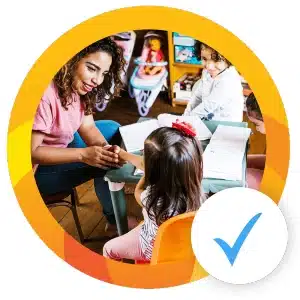
The lesson procedure describes what you’ll actually do during the lesson. This should be the longest and most detailed part of your lesson plan. Your lesson procedure will address each learning objective so you can plan activities that will effectively help your students reach those objectives.
A good daycare lesson procedure includes:
- Introduction or motivation, to get students interested in and thinking about the topic
- Learning activities to help students explore the topic from multiple perspectives and meet different learning needs
- An opportunity for students to practice or apply what they learned
- Reflection activities where students summarize what they learned and why it matters
- Progress assessment according to your objectives
- A conclusion and preview, where you summarize, answer lingering questions, and link the lesson to past and future activities
Thoroughly prioritized lesson objectives will guide you in time management. Make a note of what parts of the lesson are crucial and cannot be skipped, what can be omitted if there is not enough time, and what can be added in if there is more time than expected.
5. Evaluation & Assessment
Depending on your objectives and the needs of your students, different evaluation methods may work for your lesson. Quizzes and homework are common methods of evaluation for older kids, but for younger kids, less formal assessment methods are often appropriate. This usually means making notes on the students’ classroom behavior and how well they completed the activities.
Your assessments should be objective, recording facts, not opinions. Report on the expected milestones in each learning domain according to your state standards. You can also involve parents in your assessments by sharing learning outcomes via a mobile family engagement app.
6. Reflection
Although it’s part of a lesson plan, a lesson reflection takes place after the lesson. By reflecting on your lesson and its success, your lesson plans can become records of your teaching, too. Take a few minutes after every lesson to ask how well you met your learning objectives and time goals. What went right? What could be improved for next time?
Five Lesson Planning Tips for Your Child Care Center

1. Plan Alternative Activities (Just in Case)
Outdoor time rained out? Ran out of glue sticks? Power outage in the classroom? Taking the time to identify how your child care lesson plan can be modified, as well as having a few activities on hand for times when your lesson is unexpectedly impossible, will let you be sure your students have a positive learning experience no matter what.
2. Assess the Needs of Your Learners
Each student progresses through developmental milestones at their own rate and has their own learning style. Carefully tracking students’ progress lets you understand their individual learning needs, which means you can plan lessons that help every student reach their full potential.
3. Make Lessons Fun and Challenging
Fun and challenging are equally important aspects of learning, and when learning is at its best, they go hand in hand. Kids love activities that push them to grow and let them exercise their creative abilities at the same time. And sometimes, a challenge can be fun for its own sake, giving children the opportunity to prove to themselves and others that they have mastered a new skill.
4. Organize Themed Lessons into Units
Educational units are a bridge between the broad curriculum and the day-to-day lesson plan. A theme gives kids a sense of continuity, helping them make connections to what they have learned in the past and know what to expect in the future. Units join lessons into a learning arc with defined outcomes, and help you set milestones throughout the year.
5. Value Engagement over Direct Instruction
Most child development experts agree that children learn through active engagement with the world, not just passive absorption of information. Play-based learning is key for kids to develop their own understanding of concepts and gain confidence in their abilities. Plus, it keeps learning fun, so kids will maintain a love of learning throughout their lifetimes.
How a Digital Curriculum Designed for ECE Can Help!
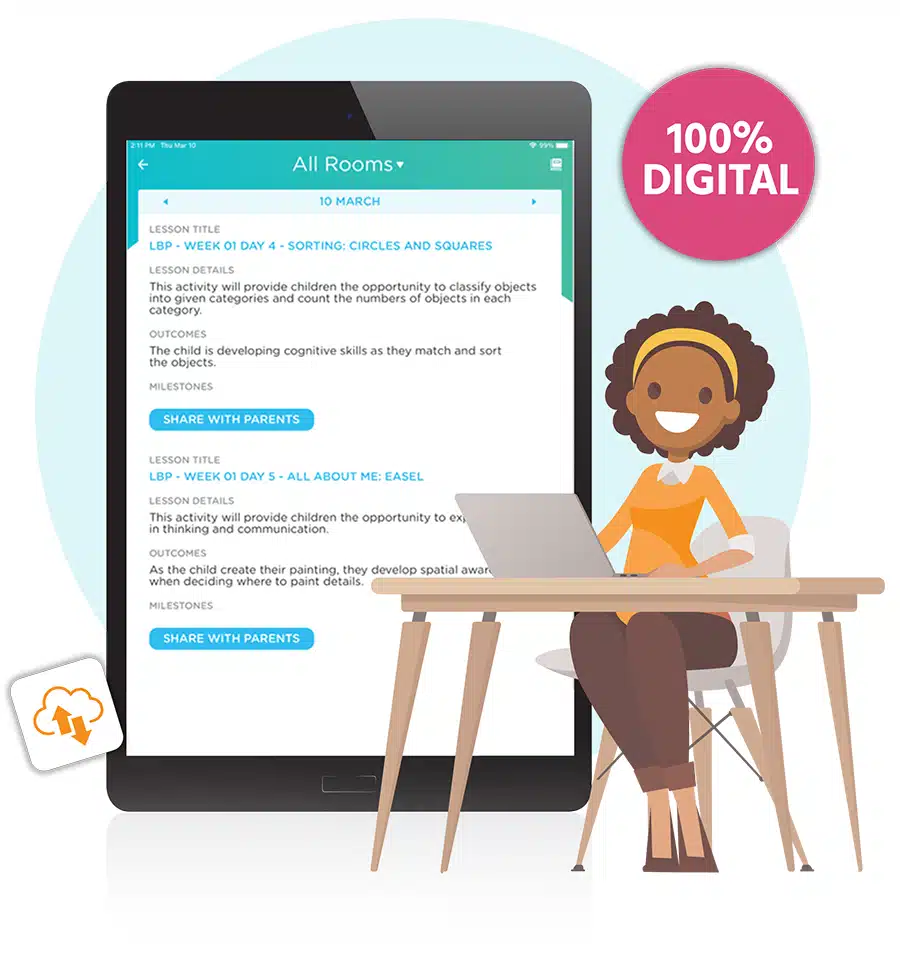
Consider a curriculum designed for young learners with built-in lesson plans that are age specific!
Procare Early Learning powered by Learning Beyond Paper is an all-digital early childhood curriculum specifically designed to meet the unique needs of educating children from infancy through pre-kindergarten.
The curriculum is embedded into Procare, making it easier and less time-consuming for busy teachers and administrators to provide high-quality education.
With Procare Early Learning powered by Learning Beyond Paper, child care centers can:
- Equip teachers with state-of-the-art online curriculum at their fingertips
- Dramatically reduce the amount of time spent on lesson planning each week
- Offer children a high-quality, developmentally appropriate curriculum
- Save money with this cost-efficient solution that’s integrated with Procare
This curriculum can be used in ALL child care center classrooms, with 52 weeks of lesson plans and thousands of daily activities for infants, toddlers, preschoolers and pre-kindergarteners. Learning areas include STEAM, language and literacy, physical development, cognitive, music and movement as well as interactive reading. Plus, teachers get tips and tools.
Procare is the only solution that can deliver the entire early childhood education ecosystem — lesson planning, lesson delivery within the classroom as well as assessment and parent engagement. Being able to do all of these with one platform simplifies classroom management and planning!
How much time and money could your child care center save using a digital curriculum designed for young learners? Enter your number of staff, number of students and type of program into our online calculator to see your potential time and money savings!


